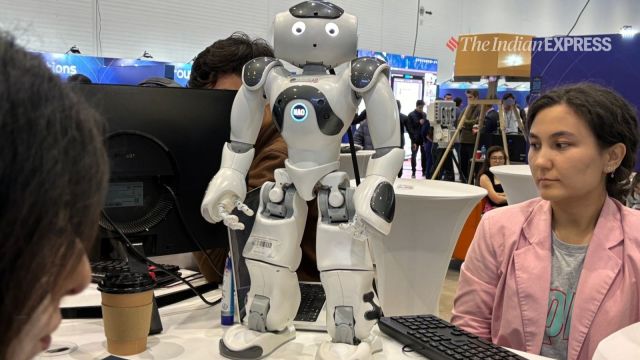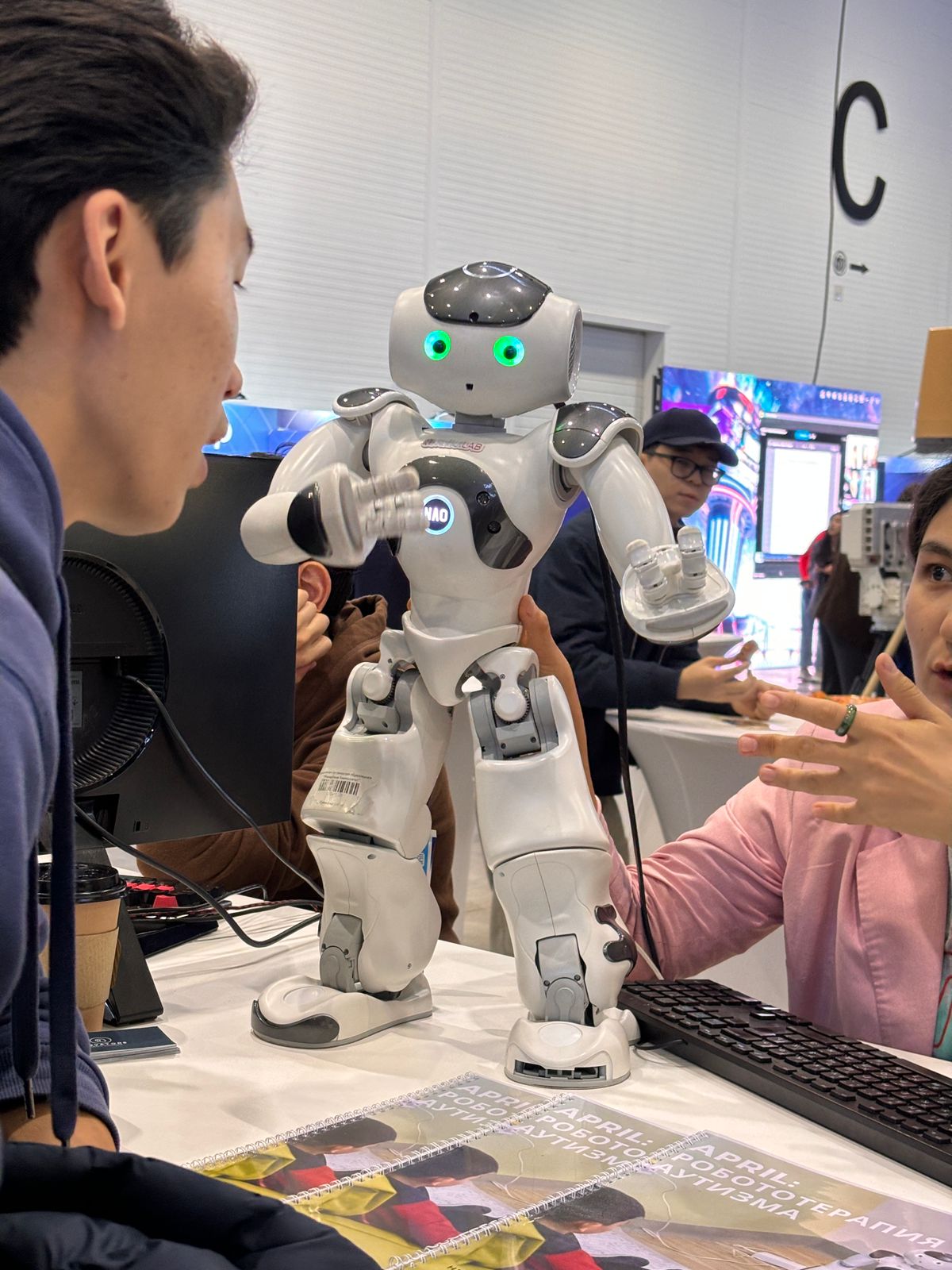- India
- International
Meet NAO, the social robot spearheading a new wave of autism treatment in Kazakhstan
NAO, a humanoid robot developed by April, a research organisation in Astana, Kazakhstan, deploys traditional methodologies to treat children with autism.
 NAO is an outcome of Sandygulova and her team’s six years of research that delved deep into the robot-assisted autism therapy. (Image: Bijin Jose/The Indian Express)
NAO is an outcome of Sandygulova and her team’s six years of research that delved deep into the robot-assisted autism therapy. (Image: Bijin Jose/The Indian Express) The longing gaze of a child can hold immeasurable power. Young Iliyana’s mother, Anya(name changed), yearned for seven long years to witness this profound moment – the instant when her daughter’s eyes would meet hers. And then, on one extraordinary day, it happened. Iliyana looked into the hazel eyes of Anya, and in that fleeting moment, tears of joy flowed freely.
Anara Sandygulova, who stood witness to this heartwarming scene, said, “It is stories like these that have inspired me to embark on a journey of child-robot interactions, to bring the transformative power of robotics to help children with autism.” The seven-year-old did something remarkable just a few weeks after she was trained using a robot developed by Sandygulova’s firm.
Sandygulova is an associate professor at Nazarbayev University in Astana, Kazakhstan. Her expertise lies in human-robot interaction, social robotics, and artificial intelligence. She currently runs April, a company that specialises in social robots that facilitate robot-assisted autism therapy.
The researcher was at the Digital Bridge 2023 in Astana, Kazakhstan, to share her unique journey. Sandygulova’s passion for child-robot interaction during her PhD studies laid the foundation for April. Indianexpress.com sat with Sandygulova to learn more about the landscape of robotics in autism therapy and the affable social robot – NAO.
Social robots to aid therapists

Autism, a developmental disorder, can be crippling as it often makes social interaction for children challenging. When it comes to traditional therapies, specialists usually work towards engaging children who find it extremely difficult to focus. A significant amount of their time is spent trying to capture the attention of these children. Sandygulova’s company has developed NAO, which is making it easier for therapists and parents to engage with children with autism.
“NAO’s primary role is to assist specialists, making the therapy sessions effortless and more effective. With the robot’s intervention, the child’s focus is almost immediate, increasing compliance and effectiveness of the therapy,” said Sandygulova.
 NAO being demonstrated at the Digital Bridge 2023 in Astana, Kazakhstan. (Image: Bijin Jose/The Indian Express)
NAO being demonstrated at the Digital Bridge 2023 in Astana, Kazakhstan. (Image: Bijin Jose/The Indian Express)
According to Sandygulova, the main concern for parents of children with Autism was tracking their progress. April addressed this by bringing a web interface that logs in a child’s activities with NAO. The log acts as a digital diary for parents to monitor their child’s interactions, check for improvements or even look for areas that need more attention.
NAO is an outcome of Sandygulova and her team’s six years of research that delved deep into robot-assisted autism therapy. The team has published over ten research papers, and one of them was acknowledged by an Autism conference in Sweden. “In April this year, autism centres approached us, leading to the creation of this company,” she said.
For children and parents
The NAO robots are currently operational in four centres in Kazakhstan, and Sandygulova revealed that her company has plans to add 18 more centres by the end of 2024. The four centres operating right now treat nearly 400 children, with over 40 specialists who have been trained to use these robots. These centres also host seminars for parents, whom Sandygulova calls their primary advocates.
According to Sandygulova, the robots’ uniqueness lies in their programming. “Everything is evidence-based. These are techniques that are already used everywhere in the world but without robots. So, we take these techniques, for example, Applied Behavior Analysis (ABA) therapy, which is a very well-known therapy that is used, Social Stories, Picture Exchange Communication Systems, and other methodologies.”
 Sandygulova is an associate professor at Nazarbayev University in Astana, Kazakhstan. (Image: Novator.KZ)
Sandygulova is an associate professor at Nazarbayev University in Astana, Kazakhstan. (Image: Novator.KZ)
“There are 22 different methodologies in total that we program onto our social robots, which is bringing the best expertise that we got from autism research onto robotics, as a technology, and then we have this solution.”
Robots add an element of fun
When asked about the advantages of robots in autism therapy, Sandygulova said that the robot’s main ability is to command attention. Instead of therapists struggling to engage with the child, these robots ensure that the child is attentive, making sessions more productive. The robots also introduce a reward system. Instead of traditional rewards like sweets and cartoons, playing with the robot often serves as an incentive, making therapy sessions enjoyable.
While a robot like NAO is helping children with autism, Sandygulova asserts that the technology is not limited to autism therapy centres. She said that there is a demand for learning the Kazakh language among Russian-speaking students, and NAO can be a fun way to learn a language. NAO is designed to teach cognitive skills that are essential for every child, from basic arithmetic to language. And according to Sandygulova, this expands the robot’s use cases beyond autism therapy.
NAO is priced at USD 6,500 (about Rs 5.42 lakh). Although the robot is designed for therapy centres, Sandygulova shared that there were families who were willing to spend that much to bring NAO to their homes. While setting up the robot at therapy centres can face some challenges, at home, it would be relatively simple. “One of the challenges faced by us was the initial setup in centres, especially in areas with unreliable internet. This was addressed by providing hands-on training, ensuring that the therapists are equipped to troubleshoot any issues if they arise,” she said.
At present, Sandygulova is tasked with expanding the number of robot-assisted autism therapy centres across Kazakhstan, with two centres in every city. However, when asked about her plans to expand to a country like India, Sandygulova expressed keen interest in bringing the robot-assisted therapy here. “We have lessons in Russian and Kazakh, and since we have it in English, translating the same in Hindi won’t be an issue.”
Autism is prevalent in India. According to a report published in 2022, about 18 million people are diagnosed with autism. Nearly 1 to 1.5 per cent of children between two and nine years of age are diagnosed with Autism spectrum disorder (ASD). Something like robot-assisted autism therapy can be pathbreaking in India.
May 06: Latest News
- 01
- 02
- 03
- 04
- 05







































